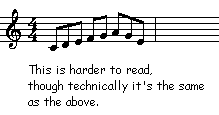Answer: In music it is not a sure thing that logic will be involved. But for beaming notes some logic is available, though you'll still sometimes find notes beamed capriciously. First there's the kind of beaming traditionally used for vocal music: notes sung to the same syllable are beamed together if they are eighth notes or less. But separate syllables are not beamed, as below:

Then there is instrumental practice, which is what you'll see most often. I like the instrumental practice even for vocal music, though tastes differ. In music for instruments the usual thing is to beam in such a way that the beat groups are clear. If two eighths are on the same beat then they are beamed together. In 2/2 time, where the beat has the value of 4 eighth notes, you'd beam 4 of them together. Here enters a matter of personal taste: even in 4/4, where one beat is worth 2 eighth notes, you'll often see 4 eighths beamed together. And that's good - if they are either the first or the last half of the measure (i.e., not crossing the center of the measure). That way the basic nature of the meter is reflected in the beaming: a 4/4 measure divides naturally at its middle with the start of the 3rd beat, the second-most important beat in a 4/4 measure. But if the meter is a compound 6/8 (beat equals a dotted quarter, equal to 3 eighth notes) then you'd beam in threes so that the beat is easy to see. Good notation is all about communication: the point is to make it easy to read and to understand the composer's intentions.
There's a discussion of this with more examples on pages 16-17 of Exploring Theory. See also question 36.



